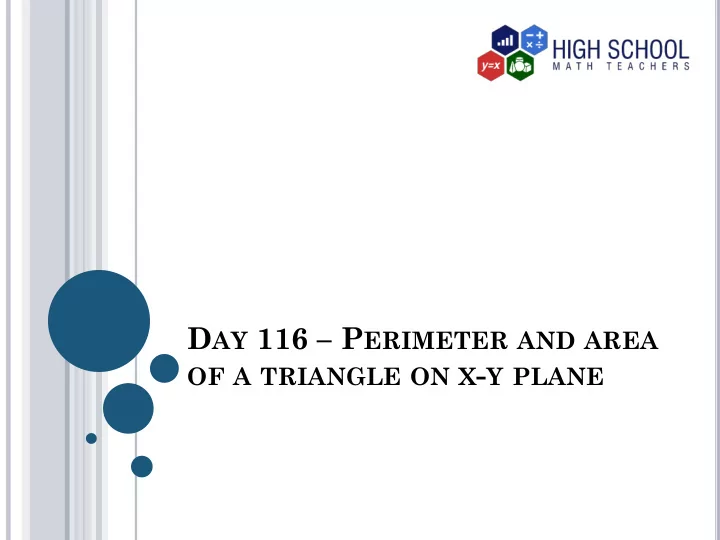

D AY 116 – P ERIMETER AND AREA OF A TRIANGLE ON X - Y PLANE
I NTRODUCTION We have different ways in which we can use to find the area of a triangle. Some of these ways 1 1 include using the formula 2 𝑐ℎ , 2 𝑏𝑐 sin 𝜄 and using Heron’s formula. However, some of these methods may not help us to find the area of a triangle when we are only given the coordinates of its vertices. We have to perform a number of computations to use them. In this lesson, we will find the area and the perimeter of triangle on xy- plane.
V OCABULARY Perimeter This is the distance around a shape on a plane.
Finding perimeter of a triangle on xy- plane From the definition of the perimeter, we find the perimeter of a triangle by adding the lengths of all the three sides. The length from one vertex to another is found using the distance formula. The distance formula If 𝐵(𝑦 1 , 𝑧 1 ) and B (𝑦 2 , 𝑧 2 ) are two points on xy- plane, the distance from A to B is given by the formula, (𝑦 2 − 𝑦 1 ) 2 +(𝑧 2 − 𝑧 1 ) 2
Example 1 Find the length of a triangle with vertices and hence, the perimeter at 𝐵 −4, −4 , 𝐶(8, −4) and 𝐷(8,1) . Solution 8 − −4 2 + (−4 − −4) 2 Distance from A to B is = 12 −4 − 1 2 + (8 − 8) 2 Distance from B to C is = 5 8 − −4 2 + (1 − −4) 2 Distance from B to C is = 13 Perimeter of ∆𝐵𝐶𝐷 = 𝐵𝐶 + 𝐶𝐷 + 𝐵𝐷 =12+5+13 = 30 𝑣𝑜𝑗𝑢𝑡
Finding the area of a triangle on xy- plane We can use Heron’s formula to find the area of a triangle after getting the perimeter. According to Heron’s formula, Area of Triangle = 𝑡(𝑡 − 𝑏)(𝑡 − 𝑐)(𝑡 − 𝑑) 1 where s = 2 𝑢ℎ𝑓 𝑞𝑓𝑠𝑗𝑛𝑓𝑢𝑓𝑠 and a,b,c are lengths of each side. If we use this formula to find area of the ∆𝐵𝐶𝐷 in 30 example 1 above, 𝑡 = 2 , 𝑏 = 12, 𝑐 = 5 and 𝑑 = 13 . 𝐵 = 15(15 − 12)(15 − 5)(15 − 13) 𝐵 = 15 × 3 × 10 × 2 𝐵 = 900 = 30 𝑡𝑟. 𝑣𝑜𝑗𝑢𝑡
However, Heron’s formula can be tedious especially when the lengths of the sides are irrational numbers. Given a triangle with vertices at 𝑦 1 , 𝑧 1 , 𝑦 2 , 𝑧 2 , (𝑦 3 , 𝑧 3 ) a simpler way to find the area of triangle is to use the formula, 1 𝐵 = 2 (𝑦 1 𝑧 2 − 𝑧 3 + 𝑦 2 𝑧 3 − 𝑧 1 + 𝑦 3 𝑧 1 − 𝑧 2 ) This formula can easily be remembered by finding half the value of the determinant of the matrix, 1 1 1 𝑦 1 𝑦 2 𝑦 3 𝑧 1 𝑧 2 𝑧 3
Example 2 Find the area of a triangle with vertices at 1,1 , 4,2 and (1,4) . Solution Let 1,1 , 4,2 and (1,4) be 𝑦 1 , 𝑧 1 , 𝑦 2 , 𝑧 2 and (𝑦 3 , 𝑧 3 ) 1 𝐵 = 2 (𝑦 1 𝑧 2 − 𝑧 3 + 𝑦 2 𝑧 3 − 𝑧 1 + 𝑦 3 𝑧 1 − 𝑧 2 ) 1 𝐵 = 2 (1 2 − 4 + 4 4 − 1 + 1(1 − 2) 1 𝐵 = 2 −2 + 4 3 − 1 𝐵 = 4.5 𝑡𝑟 𝑣𝑜𝑗𝑢𝑡
HOMEWORK Find the perimeter of a triangle with vertices at 4,2 , 12,2 𝑏𝑜𝑒 2,8 .
A NSWERS TO HOMEWORK 24 𝑣𝑜𝑗𝑢𝑡
THE END
Recommend
More recommend